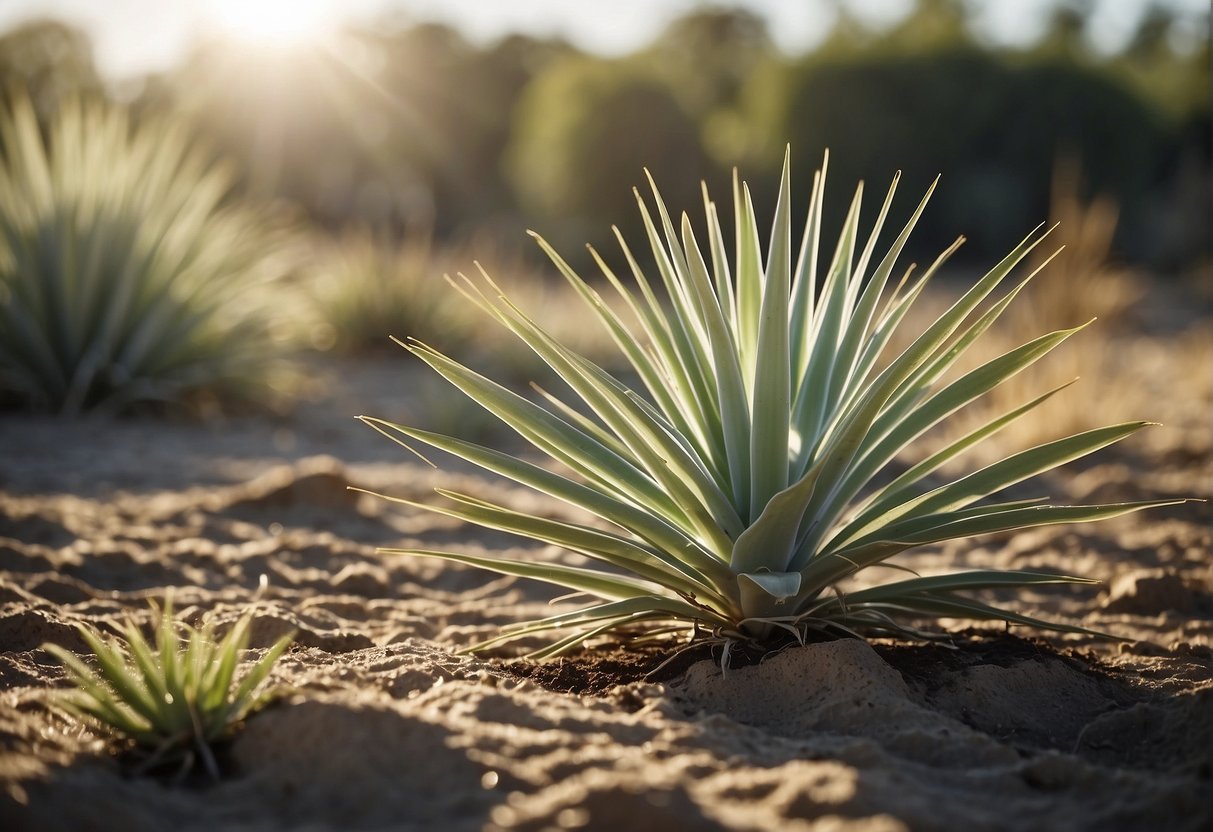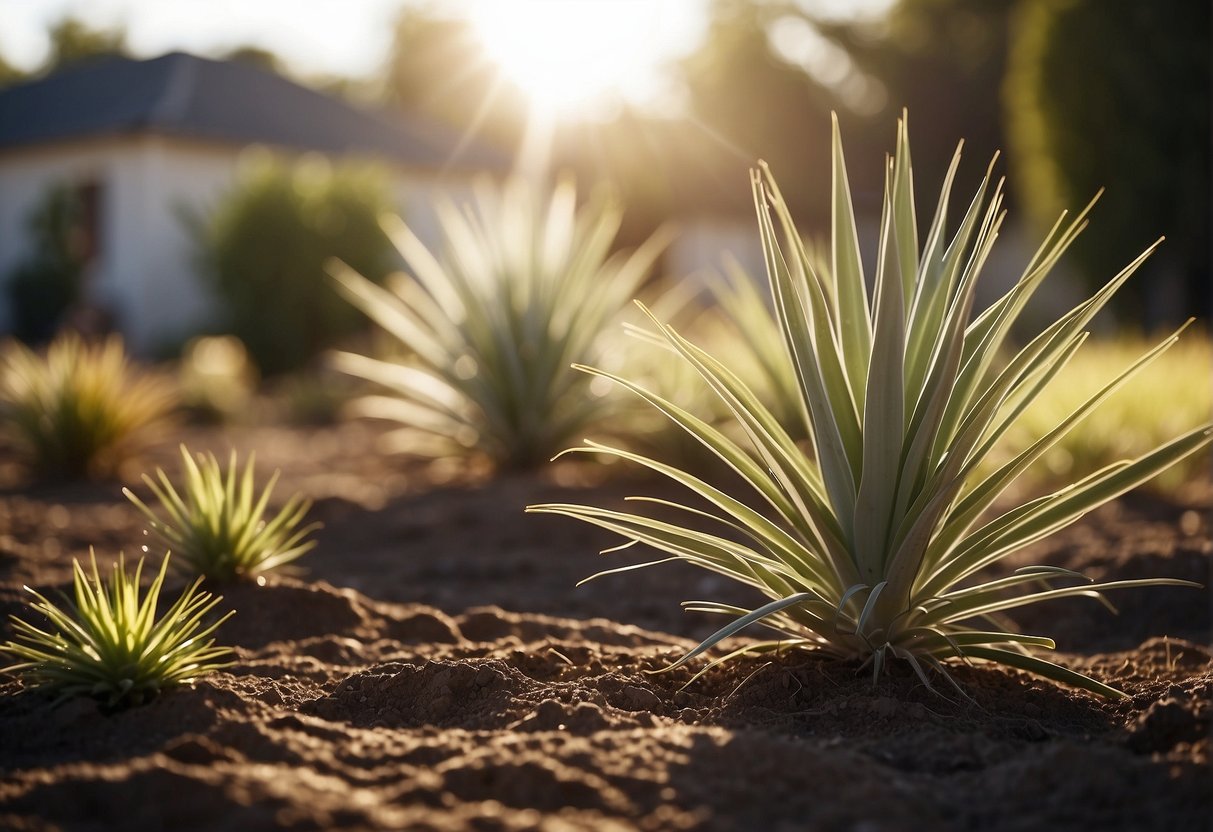How to Care for Yucca Plants Outside: Tips and Tricks
If you’re in search of a low-maintenance addition for your garden, consider the yucca plant an excellent option. It’s not only simple to maintain, but its tall, spiky foliage and occasional flowering also provide a distinctive appearance. Nonetheless, despite its ease of care, it requires adequate attention and care to flourish in your garden.

One of the first things to consider when caring for your yucca plant outside is selecting the right location. Yucca plants thrive in full sun and well-draining soil, so make sure to choose a spot that gets plenty of sunlight and has soil that won’t hold onto too much moisture. Once you’ve found the perfect spot, it’s time to plant and give your yucca plant its initial care.
Key Takeaways
- Yucca plants are a great low-maintenance addition to your outdoor garden.
- Select a location with full sun and well-draining soil for your yucca plant.
- Proper planting, watering, and ongoing maintenance will help your yucca plant thrive.
Selecting the Right Location

When it comes to caring for yucca plants outside, selecting the right location is crucial. Yucca plants are well-suited for outdoor gardens, but they require specific conditions to thrive. Here are some things to consider when selecting the right location for your yucca plant.
Understanding Sunlight Needs
Yucca plants require full sun to grow and thrive. When selecting a location for your yucca plant, make sure it is in an area that receives at least 6 hours of direct sunlight per day. If your garden is shaded, consider planting your yucca plant in a container that can be moved to a sunnier location.
Soil Requirements
Yucca plants prefer well-drained soil. They do not do well in soil that is too wet or too dry. When selecting a location for your yucca plant, make sure the soil is well-draining. If your soil is heavy or clay-like, consider amending it with sand or perlite to improve drainage.
Overall, selecting the right location for your yucca plant is essential to its success. By understanding its sunlight and soil requirements, you can ensure that your yucca plant thrives in your garden.
Planting and Initial Care
Proper Planting Technique
When planting your yucca plant outside, it is important to choose a location with well-draining soil and full sun exposure. Yucca plants are tolerant of a wide range of soil types, but they prefer soil that is slightly acidic to neutral with a pH between 6.0 and 7.5.
To plant your yucca, dig a hole that is twice as wide and deep as the root ball. Gently remove the plant from its container and loosen any tangled or circling roots. Place the plant in the hole and backfill with soil, making sure to tamp down the soil lightly as you go to remove any air pockets. Water the plant thoroughly to help settle the soil.
Watering and Feeding Schedule
Proper watering is essential for the health of your yucca plant. During the spring and early spring, water your plant deeply once a week. As the weather gets warmer, increase watering to twice a week. Yucca plants are drought-tolerant, so be careful not to overwater as this can lead to root rot.
In terms of feeding, yucca plants do not require a lot of fertilizer. In fact, too much fertilizer can actually harm the plant. Fertilize your yucca once a month during the growing season with a balanced fertilizer, such as a 10-10-10 or 20-20-20 blend. Be sure to follow the instructions on the fertilizer package carefully to avoid over-fertilizing.
By following these planting and initial care tips, you can help ensure that your yucca plant thrives in its new outdoor home.
Ongoing Maintenance and Care

Taking care of your yucca plants outside is crucial to ensure their health and longevity. Here are some tips for ongoing maintenance and care:
Pruning and Trimming
Regular pruning and trimming are essential for keeping your yucca plants healthy and looking their best. Remove any dead or damaged leaves or stems as soon as you notice them, as they can attract pests and diseases.
To prune your yucca plant, use sharp, clean pruning shears to cut the stem just above the leaf or stem joint. Avoid cutting too close to the trunk, as this can damage the plant.
Trimming your yucca plant involves removing any overgrown or unsightly leaves or stems. Use the same technique as pruning, but make sure to cut at an angle to prevent water from collecting on the cut surface.
Managing Pests and Diseases
Yucca plants are generally hardy and resistant to pests and diseases, but they can still be affected by common garden pests such as mealybugs, scale, and aphids.
To prevent these pests from taking hold, keep your yucca plant healthy by providing adequate water and nutrients. If you do notice pests, you can try removing them by hand or using a mild soap and water solution.
Yucca plants can also be susceptible to fungal diseases such as root rot and leaf spot. To prevent these diseases, avoid overwatering your plant and make sure it has good drainage. If you notice any signs of disease, remove the affected leaves or stems and treat the plant with a fungicide.
By following these simple tips for ongoing maintenance and care, you can keep your yucca plants looking healthy and beautiful for years to come.
Propagation and Repotting
Propagating New Yucca Plants
Yucca plants can be propagated by using offsets. These are small plants that grow from the main plant’s roots. To propagate a new yucca plant, you need to remove an offset from the main plant. You can do this by gently digging around the offset with a small shovel or trowel. Once you have exposed the roots, you can gently pull the offset away from the main plant. Be careful not to damage the roots of the main plant.
After you have removed the offset, you can plant it in a new pot. Make sure the pot has drainage holes and is filled with a well-draining soil mix. Water the new plant thoroughly and place it in a bright, sunny location. It may take several weeks for the new plant to establish roots and start growing.
When and How to Repot
Yucca plants should be repotted every two to three years. Signs that your yucca plant needs to be repotted include roots growing out of the drainage holes, the soil drying out quickly, or the plant becoming top-heavy and unstable.
To repot your yucca plant, gently remove it from its current pot and shake off any excess soil. Inspect the roots for signs of root rot or damage. If you see any brown or mushy roots, trim them off with a clean pair of scissors or pruning shears.
Choose a new pot that is one size larger than the current pot. Fill the bottom of the pot with a layer of gravel or rocks to improve drainage. Add a well-draining soil mix and place the plant in the center of the pot. Fill in the gaps with soil, making sure not to bury the plant too deeply. Water the plant thoroughly and place it in a bright, sunny location.
By following these simple steps, you can propagate new yucca plants and keep your existing plants healthy and thriving.
Frequently Asked Questions
What are the best practices for pruning an outdoor yucca plant?
Yucca plants require minimal pruning, but if you need to prune them, do so in the spring or summer. Cut the stem or leaf as close to the base as possible, and wear gloves to protect yourself from the sharp edges of the leaves.
Can yucca plants survive winter conditions outdoors, and if so, how should they be cared for?
Most yucca plants can survive winter conditions outdoors, but it depends on the species and the severity of the winter. If you live in a cold climate, protect your yucca plant by covering it with a blanket or burlap during the winter. You can also apply a layer of mulch around the base of the plant to protect the roots from freezing.
How should I water my yucca plant when it’s outside?
Yucca plants are drought-resistant, so they don’t need to be watered frequently. Water your outdoor yucca plant once a week during the growing season, and reduce watering to once every two to three weeks during the winter. Make sure the soil is well-draining to prevent root rot.
What type of soil is most suitable for outdoor yucca plants?
Yucca plants prefer well-draining soil that is slightly acidic to neutral. A mixture of sand and loam is ideal for outdoor yucca plants. Avoid heavy clay soils that can retain too much water and cause root rot.
Are there any common diseases or pests that affect yucca plants outdoors, and how can they be treated?
Yucca plants are generally resistant to pests and diseases, but they can be affected by scale insects, mealybugs, and fungal diseases. Use insecticidal soap or neem oil to treat pests, and remove infected leaves to prevent the spread of fungal diseases.
How much sunlight does an outdoor yucca plant require for optimal growth?
Yucca plants require full sun to partial shade for optimal growth. They can tolerate some shade, but too much shade can result in weak growth and fewer flowers. Place your outdoor yucca plant in a location that receives at least six hours of direct sunlight per day.

